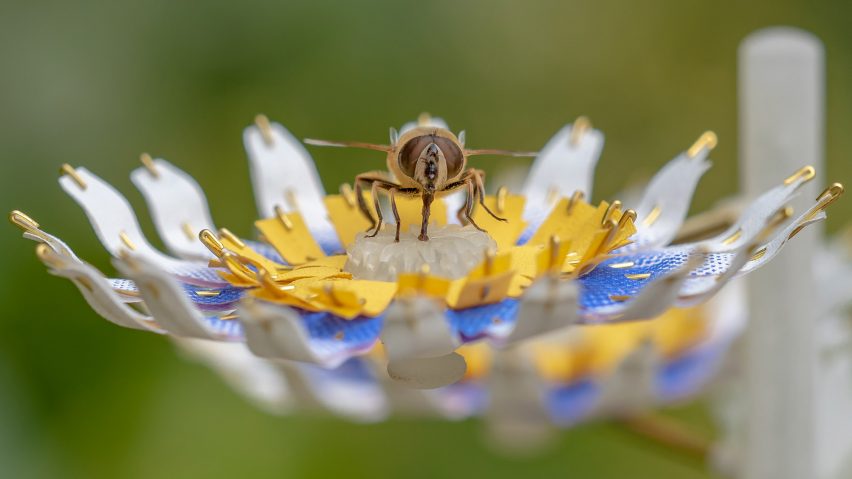Dutch designer Matilde Boelhouwer has designed a series of artificial flowers that turn rain into sugar water, to serve as emergency food sources for city-dwelling insect pollinators.
The project, called Food for Buzz, saw Boelhouwer use screen-printed polyester to create five artificial flowers, each with specific qualities that attract the "big five of pollination" – bees, bumblebees, hoverflies, butterflies and moths.
The man-made flowers are designed to act as emergency food sources for these insects, all of which live in urban environments, where flowers and planted areas are often few and far between.
"For me, the relationship between flowers and insects is one of the most fascinating connections found in nature. Flowers evolved to serve insects, and insects evolved to serve flowers simultaneously," said the designer.
"Nowadays, however, with all of us living in urban jungles made of concrete and stone, the presence of flowers has become something less natural. This lack of flowering has resulted in a drastic insect population decline."
Each self-sustaining flower is made up of a series of laser-cut screen-printed polyester petals, with a small 3D-printed container attached at the centre, which is connected to a hollow 3D-printed stem.
These containers are used to collect and contain rainwater, which is transported down the stem to a tank containing sugar, where the two mix together. The solution is then automatically pumped back up into the small containers.
Boelhouwer was motivated to start the project after becoming aware of the vast decline in insect population. According to research she conducted in Germany, over the last 27 years the insect population has declined by 75 per cent across both rural and city areas.
The designer found that this decline is due to the use of pesticides, climate change and a lack of habitat and food for the insects.
"Since the use of pesticides is regulated, and climate change is something I can't change on my own in a short period of time, I decided to focus on working on the lack of food," she told Dezeen.
Boelhouwer worked with entomologists to give each flower certain qualities that would attract a particular species. The containers are adjusted to the length of the tongue of each insect species, while the petals are patterned and coloured in the shapes and hues that the insects find most attractive.
She found three archetypical flower shapes most favoured by the five insects – Asteraceae, or the daisy family, which is preferred by bees and hoverflies, Fabaceae, or the pea family, which attracts moths and butterflies, and Lamiaceae, or mint, which bumblebees like best.
As bees see the world as honeycomb-shaped pixels, they rely heavily on their colour vision range of green, blue, violet and yellow to navigate. To attract bees from afar, Boelhouwer used a contrast of violet and yellow.
Unlike bees, bumblebees are more attracted to mirror symmetry in flowers. Boelhouwer therefore kept these designs simple using only three flower petals that form a "striking silhouette". Using yellow to colour the feeding area ensures the sugar water is easy to find.
According to Boelhouwer, hoverflies have particularly short tongues, which limits them when it comes to eating. They therefore search for flowers that are easy to access and have a shallow nectar source.
Boelhouwer created a dome-shaped reservoir at the centre of the flower that, when filled to the top, is easily accessible for hoverflies.
As butterflies tend to have a long tongue – around two to five centimetres – they need more time to feed, so they typically choose flowers with a larger bottom petal to give them more stability to rest. Unlike other insects, butterflies also prefer pink, orange and red flowers.
Moths have an even longer proboscis, or tubular sucking mouthpiece, reaching lengths of 20 centimetres. They eat when they're still flying, usually during nighttime, and navigate by lighter colours, so Boelhouwer designed a flower with raised, 3D dots to help them source the food.
Boelhouwer's aim is to introduce these flowers into spaces where they couldn't normally grow, using them to cover whole city buildings.
She hopes she can work together with architects, civil engineers and city developers to implement this in order to have a sufficient impact on the insect population.
The Food for Buzz project was launched during this year's Dutch Design Week, which took place from 20 to 28 October 2018 in Eindhoven.
At the event, Dezeen hosted a special edition of our Good Design for a Bad World talks, where we asked if design can harness humans' negative effects on earth to prevent global catastrophe.

